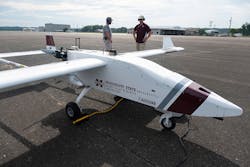General Atomics Aeronautical Systems successfully completes Gray Eagle Extended Range drone demonstration
In this week’s roundup from the Association for Unmanned Vehicle Systems International, which highlights some of the latest news and headlines in unmanned vehicles and robotics, General Atomics completes a demo of a new long-range UAS, Samsung taps drones to serve 5G networks, and the FAA designates a safety research facility at a major university.
GA-ASI completes month-long demonstration of GE-ER UAS
General Atomics Aeronautical Systems Inc. (GA-ASI) has announced the completion of a month-long demo event that showcased its Gray Eagle Extended Range (GE-ER) UAS equipped with a suite of long-range sensors, Air Launched Effects (ALE) and Scalable Command and Control (SC2).
GA-ASI collaborated with industry to equip the UAS with best-of-breed long-range intelligence, surveillance, and reconnaissance (ISR) payloads and ALEs. During the demo, the UAS showed a persistent stand-off survivability with stand-in capabilities with up to 40 hours of endurance that Army Commanders can use to orchestrate forces in the Multi-Domain Operations (MDO) environment.
“We set out on a mission to demonstrate survivability and capability to the U.S. Army through strong industry partnerships in a cost conscious and affordable way,” explains David R. Alexander, president, GA-ASI.
“The goal was to take the Army’s concepts and put the power of industry innovation to work to make them a reality. We are in the business of solving problems and ensuring the U.S. Army Soldier has overmatch on the battlefield.”
This latest demo was the third in a series of demonstrations for the U.S. Army that were based out of the Yuma Proving Grounds dating back to Nov. 2019. Building off of the previous demos, the third saw the GE-ER identify emitters with Communications Intelligence (COMINT) payload and integrated antenna array while in flight at 25,000 feet.
This configuration provided single aircraft geo-location and cross-cueing to the onboard Synthetic Aperture Radar (SAR) to produce precision coordinates sufficient for targeting within minutes. To perform the task, L3Harris’ Rio Nino lightweight COMINT system, which is capable of detecting emitters out to 250 kilometers, was combined with GA-ASI’s Lynx Multi-mode Radar with SAR.
Additionally, the GE-ER used a Sierra Nevada Small SWAP Auto-ELINT (SSAE) system to collect Electronic Intelligence (ELINT). The ELINT detections were cross-cued to the Lynx SAR for rapid processing of target identification and targeting coordinates.
GA-ASI also conducted the first-ever launch and control of ALEs from the GE-ER. Launched and controlled through the GE-ER, the ALEs provided real-time full-motion video to simulated ground forces over a Tactical Scalable Mobile (TSM) network. According to GA-ASI, this successful teaming between the GE-ER and Area-I’s Altius-600 ALEs “is a significant innovation milestone” that demonstrates capability required for the future battlefield.
The GE-ER also acted as a Tactical Scalable Mobile Ad-hoc Networking node, as it relayed voice and data to displaced users during the demonstration. All flight activities—including preflight, taxi, mission profiles and landing—were controlled from a GA-ASI laptop-based SC2 system, which reduced emplacement and mission launch timelines by 75 percent from the currently-fielded Ground Control Station.
Samsung to use drones to ensure quality of 5G network
Samsung will use drones as a tool to guarantee the quality and functioning of 5G networks.
The UAS will capture images of the antennas for analysis by the engineers. After performing their analysis, the engineers will determine if any intervention and maintenance is necessary.
The technology is still in the testing phase, but Samsung does plan to implement it across the globe later this year.
The initial test was conducted in Samsung’s yard using a drone and a smartphone. The smartphone will control and direct the drone and receive the results. The process takes place through an application installed on the smartphone.
Once the images of the antennas are captured, they are sent to a server in the cloud. Once the images are in the cloud, an Artificial Intelligence tool analyzes them and checks the rotation and inclination of the antennas. Specialists can then evaluate the data to check, for example, if the installation was well done or if the network needs maintenance.
The entire process, from capturing the images to returning the information, was completed in just 15 minutes.
Samsung now wants to define some extra features, which are able to adjust the position of the antennas through a mobile device or the computer.
According to Samsung, drone technology ensures the safety of its employees, as it prevents them from having to climb up to the antenna to perform the analysis of the state of the antenna and eventual intervention.
The project will also seek to control and monitor fourth-generation antennas.
Mississippi State University's Raspet Flight Research Laboratory designated as the FAA's UAS Safety Research Facility
Mississippi State University’s (MSU) Raspet Flight Research Laboratory has been designated as the FAA’s UAS Safety Research Facility.
This designation puts the research center at the forefront of studying and developing safety and certification standards as UAS continue to be integrated into U.S. airspace.
“Mississippi State University is a national research leader in many fields, and our foundational work with unmanned aircraft has positioned us, as this selection demonstrates, to help write the flight safety plan for this potentially transformational aspect of the aviation industry,” says MSU President Mark E. Keenum.
“This designation further solidifies MSU and the state of Mississippi as a leader in unmanned aircraft systems, which will bring more academic, research and economic opportunities to our state.”
In collaboration with its partner universities in the FAA’s UAS Center of Excellence, Raspet already conducts the vast majority of safety-related UAS research for civil use. The Center of Excellence—known as the Alliance for System Safety of UAS through Research Excellence (ASSURE)—is a leading research coalition of 25 universities and more than 100 government and industry partners.
MSU notes that integrating UAS into the National Airspace System would enable manned and unmanned aircraft to safely operate alongside each other using many of the same air traffic management systems and procedures.
In its role as the UAS Safety Research Facility, Raspet will address several issues including: “Validating and verifying results, recommendations and conclusions of UAS safety research from around the world; developing safety-based recommendations to inform FAA decisions on UAS policy, regulation and safety guidance; investigating technologies that enable UAS to accurately and reliably detect other aircraft and adjust the course of the UAS to maintain safe distances; successful implementation of these detect-and-avoid systems would permit UAS to safely operate beyond visual line of sight—a critical threshold for UAS to reach full potential; and serving as a performance evaluation testbed for emerging UAS technologies.”
“Raspet has a rich heritage of aviation development and testing, and we’re building upon that foundation by providing the FAA with research needed to quickly, safely and efficiently integrate UAS into the National Airspace System,” says Dallas Brooks, Raspet director.
“We’re proud the FAA has selected us as their UAS Safety Research Facility, and we’re looking forward to working together to ensure the benefits of this amazing technology are realized without compromising safety.”
Compiled by Brian Sprowl, Associate Editor, AUVSI
Share your vision-related news by contacting Dennis Scimeca, Associate Editor, Vision Systems Design
SUBSCRIBE TO OUR NEWSLETTERS

